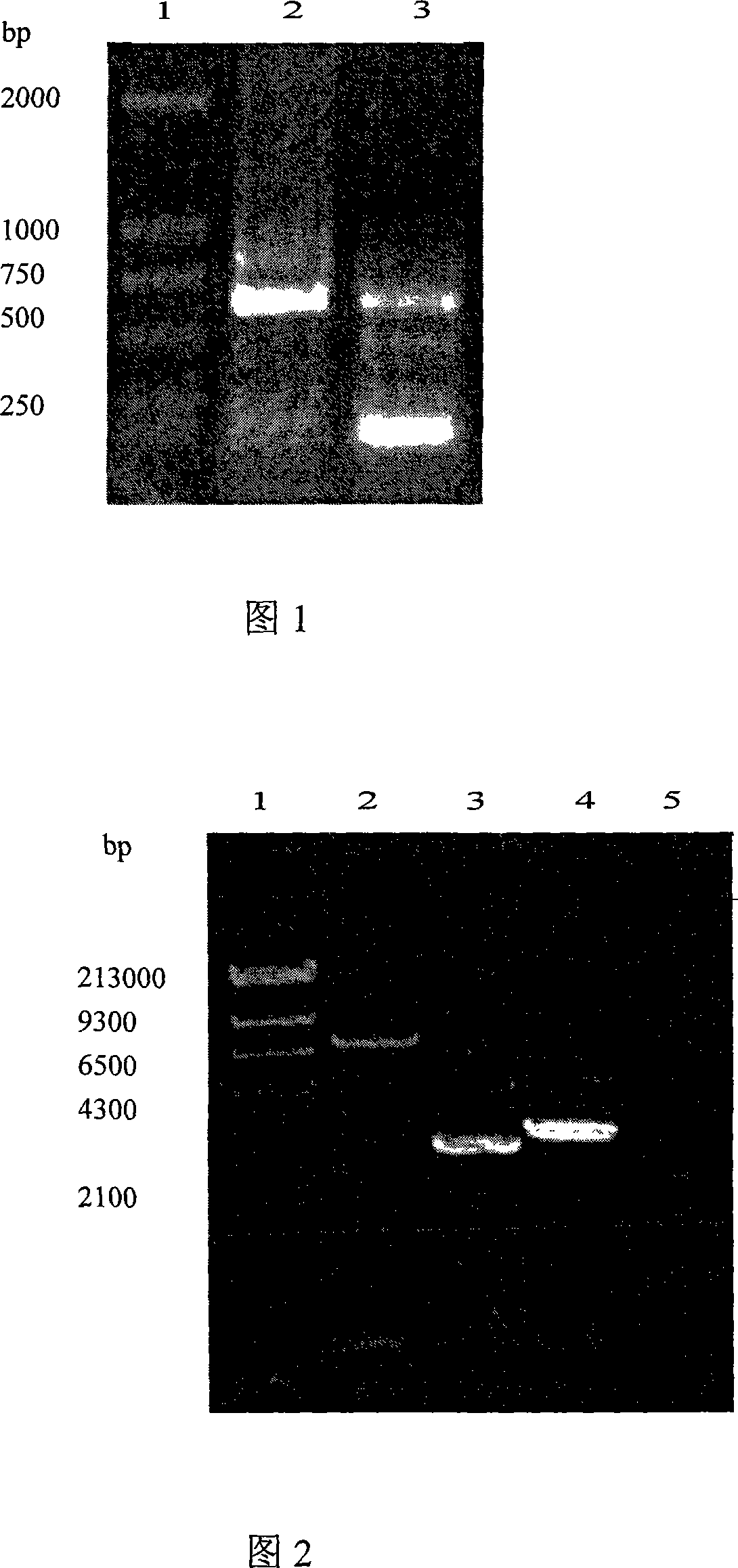Gene producing glycerin candida NAD+ depending- glycerin3- glycerophosphate dehydrogenase and clone thereof
A phosphate dehydrogenase, Candida technology, applied in genetic engineering, plant genetic improvement, fermentation, etc., can solve problems such as lack of molecular knowledge and genetic background
- Summary
- Abstract
- Description
- Claims
- Application Information
AI Technical Summary
Problems solved by technology
Method used
Image
Examples
Embodiment 1
[0048] Example 1: PCR amplification of the glycerol 3-phosphate dehydrogenase gene fragment of Candida glycerinogenes WL2002-5-59 with degenerate primers
[0049] 1. Design of degenerate primers
[0050] Search the sequences of the glycerol 3-phosphate dehydrogenase genes of related yeast and other eukaryotes published in GeneBank, and through the comparison and analysis of amino acid sequences, find the amino acid sequences corresponding to the two conserved regions VVGSGNWGT and GALKNVVA, according to these two conserved regions Design a pair of degenerate primers for the region
[0051] CD-U: 5'-TBRTBGGITCHGGYAAITGGG-3',
[0052] CD-R: 5'-RGCVAIVAYRTTYTTYARIGC-3'.
[0053] Wherein I refers to inosine base; R refers to A or G; Y refers to C or T; H refers to A, C or T; V refers to A, C or G; B refers to C, G or T.
[0054] 2. Extraction of Genomic DNA from Candida glycerinogenes WL2002-5-59
[0055] Chromosomal DNA preparation of Candida glycerologenus WL2002-5-59 was ca...
Embodiment 2
[0059] Embodiment 2: Reverse primer PCR amplifies the full-length sequence of glycerol 3-phosphate dehydrogenase gene
[0060] 1. Design of reverse PCR primers
[0061] Design a pair of reverse PCR primers according to the sequence results obtained by PCR amplification with degenerate primers
[0062] CgI-F: 5′-CCTTATTTCCGTGTTCGTGTTATTAGTG-3′
[0063] CgI-R: 5'-CGCCTTCAATCAATTCTTCATAGAC-3' was used for PCR amplification.
[0064] 2. Preparation of PCR template
[0065] Genomic DNA of C. glycerinogenes WL2002-5-59 was extracted according to the above method, and 5 μg of genomic DNA was digested with restriction enzymes BamH I, Pst I and Sal I respectively, and the digestion effect was checked by agarose electrophoresis. The digested product was extracted with equal volumes of 1:1 phenol and chloroform, then precipitated with 2.5 times the volume of absolute ethanol, and finally dissolved in 50 μL of ultrapure water. In 200 μL ligation system, add 0.1 μg digested DNA, 20 μL ...
Embodiment 3
[0068] Example 3: C. glycerinogenes glycerol 3-phosphate dehydrogenase gene sequence information and homology analysis
[0069] The nucleotide sequence of the Candida glycerologenicum glycerol 3-phosphate dehydrogenase gene of the present invention is 4900 bp in length, and the detailed sequence is shown in SEQ ID NO.1, wherein the open reading frame is at 2082-3246 nucleotides, encoding 388 amino acids , and the internal coding frame does not contain introns.
[0070] The gene sequence of Candida glycerogenes glycerol 3-phosphate dehydrogenase and its encoded protein were analyzed by BSLAT program in Non-redundant GeneBank+EMBL+DDBJ+PDB and Non-redundant GeneBank cdstranslations+PDB+SwissProt+PIR database And protein homology search, it was found that at the amino acid level, it has 70% homology with the glycerol 3-phosphate dehydrogenase gene of Pichia angus, and with the glycerol 3-phosphate dehydrogenase gene of Saccharomyces cerevisiae The genes share 60% homology. It c...
PUM
 Login to View More
Login to View More Abstract
Description
Claims
Application Information
 Login to View More
Login to View More - R&D
- Intellectual Property
- Life Sciences
- Materials
- Tech Scout
- Unparalleled Data Quality
- Higher Quality Content
- 60% Fewer Hallucinations
Browse by: Latest US Patents, China's latest patents, Technical Efficacy Thesaurus, Application Domain, Technology Topic, Popular Technical Reports.
© 2025 PatSnap. All rights reserved.Legal|Privacy policy|Modern Slavery Act Transparency Statement|Sitemap|About US| Contact US: help@patsnap.com

